“Good thing he’s on our side” … “For now”
How do we define the term ‘Monster’? Or perhaps, how should we define it? Is there ever a possibility that the monster we feared can end up being the hero we never knew we needed? This is the question posed within Michael Dougherty’s 2019 Action film Godzilla: King of the Monsters (Figure 1), when catastrophe hits the planet through the rising of Earth’s original settlers, known as ‘Titans’. The battle between human and beast comes to surface when an extraterrestrial creature ‘Ghidorah’ (Figure 2) summons himself as king of the Titans. The centuries-old conflict resumes when Godzilla (Figure 2) and his queen, Mothra (Figure 2), fight the battle which will put them back in their position of leadership. For an animal that has been considered a beast for so long, he is given an opportunity for redemption. Godzilla is a monster, but he brings a whole new meaning to it.
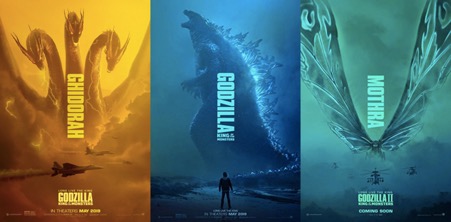
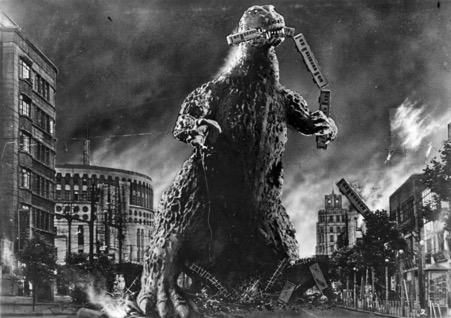
Godzilla originates from 1954 Kaiju cinema (Figures 3 and 4), a Japanese genre based around monsters. Dougherty has combined action, science fiction and fantasy to pay tribute to Godzilla’s original home. The formal elements of the film constantly work to increase the tension between the human-animal relationship. With some still not convinced they can trust him, the sound, cinematography, editing and lighting have all been used to ensure the spectator is hesitant of this relationship also. The human-animal relationship is just as conflicted as Godzilla and Ghidorah. Whilst he is the antagonist in so many people’s lives, there are some who hold a life-long love and loyalty to the monster, and these relationships get put to the test throughout the course of the film. Explosions, heroes and villains, mythical creatures, symbiotic relationships, human sacrifice, and a conflict that dates back centuries all work collaboratively to present the revolutionary human-animal relationship. If the humans want to live peacefully with the Titans, they need to have at least one on their side.
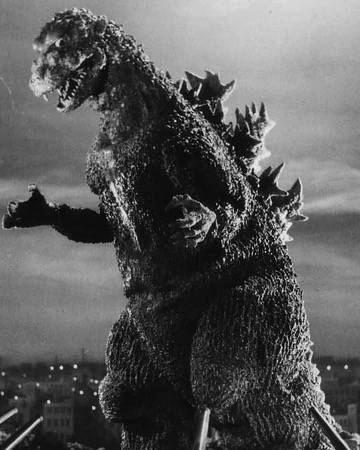
Godzilla’s relationship with Mark is explored through a reluctance of trust. This hesitancy stems from his son, Andrew, who was a victim of one of Godzilla’s city attacks. The relationship is portrayed effectively during the scene in which we first set eyes on the monster. Godzilla is closing in rapidly on the ship where Mark and a team of scientists are working to track his vitals, movement and location. The static camera cuts to the different shipmates and violently shakes as a cause of the booming intra diegetic growl of the sea monster. Through combining the visuals of the crew members and the sound of Godzilla the viewer can identify the human-animal oppositions. The sound is effective at establishing Godzilla’s power, if his growl is able to send vibrations through the whole ship, then we are left to question what else he is capable of. At this point, the spectator is placed in the same position as the characters, questioning whether he is a beast or hero. In this scene, Mark’s relationship with the Titan shows progression, with Mark suggesting to open the shields to reveal themselves to Godzilla.
The cold blue light of the monster is illuminating the ocean around him, revealing other sea life which emphasises his enormous size (Figure 5). In order to stabilise the relationship between Godzilla and the other shipmates, Dr Vivienne Graham, a supporter and expert of the creature, creates a sense of familiarity by comparing his light intimidation display to a “Gorilla pounding its chest”. Not only is this a brief link to another famous Titan ‘King Kong’, but it is associating Godzilla with a conventional animal, Graham is attempting to generate an understanding of his movements in a way that the non-experts and the viewer can understand. As soon as we are able to recognise what he is doing, the trust automatically expands.
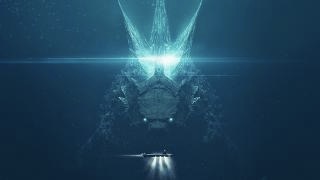
In light of its action film conventions, the sound slowly fades to silence, drawing in both the characters and the spectator, creating a false state of relaxation. This is immediately broken through a sudden burst of the intra diegetic sound of Godzilla’s deafening roar and rapid movements, which destabilises the trust that was loosely established between Mark, the other shipmates, and the viewer. At this point, we are yet to know if he can be the hero of our story.
“How many nukes do you have? We could help him”
Dr. Ishiro Serizawa has a long-term and loyal relationship with the Titan. Due to their shared Japanese heritage, the human honor to the animal can be read through a cultural lens, with Serizawa frequently using Godzilla’s Japanese name ‘Gojira’. After Ghidorah and Godzilla’s first battle, the latter becomes injured. It is Mark who proposes that they rescue him through using the nuclear bombs to regenerate his radioactivity. Not only does this highlight the desperate state of the humans, it also shows a growth in the levels of trust between Mark and the monster, going against his original death wish for Godzilla. Serizawa sacrifices himself to ensure a safe delivery of the bombs to the underwater palace of the injured King (Figure 6).
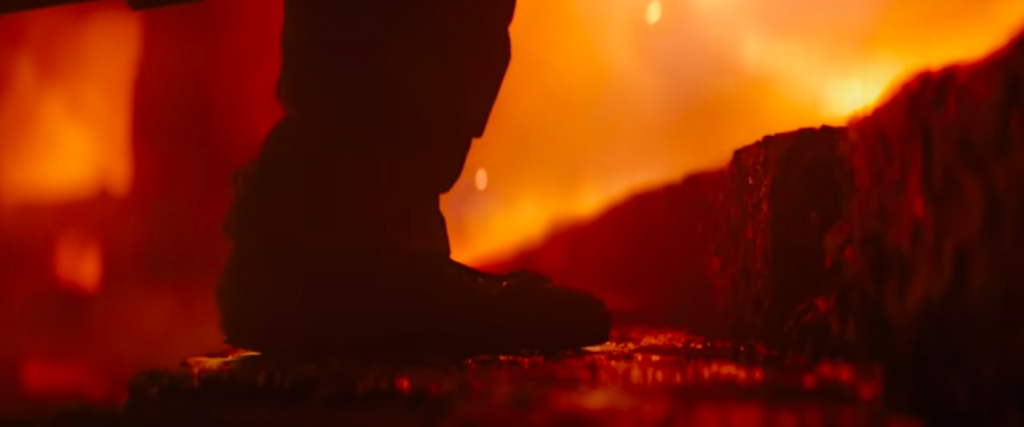
As Serizawa enters the setting, glowing images of fire and water dominate. These contrasting elements symbolise the conflict between Ghodira and Godzilla, linking to the glowing yellow fire that is ejected from Ghidorah and Godzilla’s radioactive blue light. This symbolism acts as a reminder for the reasons behind Serizawa’s actions. A soft operatic choir is layered extra diegetically over the scene (Figure 6). This music creates a nirvanic tone, as although Serizawa is ending his life so that Godzilla can live on, the slow pace and high pitch is establishing it as an honorable sacrifice, implying that Serizawa is heading to a place of peace. Once Ishiro has entered the air pocket, a close up of his foot on the step is contrasted to a wide shot of the entire staircase (Figures 7 and 8). These steps create further affiliations to the afterlife, physically walking in an upwards direction to his death. Through a combination of these camera angles, his determination can be identified as we are able to see the difficulty he has with moving his struggling body up one step, let alone the whole staircase. This highlights the extreme measures that he will go to in order for his hero to be saved, emphasising the love that he has for Godzilla.
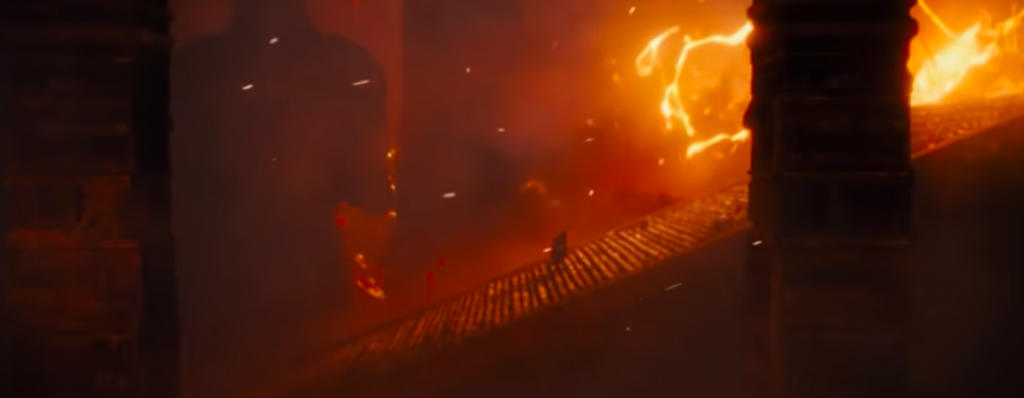
As Serizawa’s time is coming to an end, the tension of the scene is dramatically building to represent the human sacrifice. Transitioning from a soft choir, to a loud, heavy orchestra, the music is accompanied by an intra diegetic ticking of the nuclear bomb (Figure 6). A high angle shot is used to show Serizawa looking up to the injured creature whilst removing his helmet. This character movement and camera angle reference the first syllable of Godzilla’s name, showing his Godly power, as well as the deep respect and honor that Serizawa has for being in his presence. Through the editing, shots of Serizawa’s greeting of Godzilla cross cuts to the timer of the bomb, acting as a reminder of the remaining seconds he has to live, the intra diegetic sound of the bomb and the cross cuts work together to rise the tensions.
Serizawa’s last words are spoken in Japanese translating to “Goodbye old friend” (Figure 6) this establishes the intimate human-animal connection, as he is talking to Godzilla in the language of his home. The dialogue is accompanied by a close up shot showing his hand gently placed upon Godzilla’s reptilian skin, cutting to an extreme close up shot of Godzilla’s eye (Figure 9) which implies that this connection which was presumed to be one sided, has become mutual, or perhaps it was all along.
“Goodbye old friend”
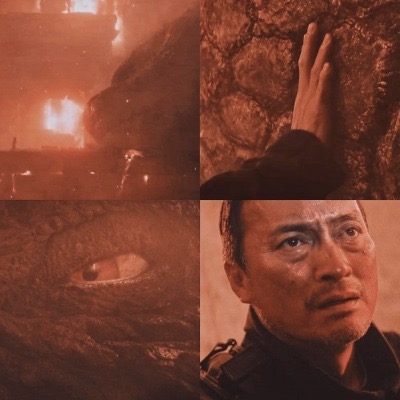
“Queen of the Monsters”
Godzilla’s symbiotic relationship with Mothra is addressed through a heteronormative lens, it is through the dialogue of a soldier who on Mothra’s entrance asks “So, her and Godzilla, they’re like… They got a thing going on? That’s kinda messed up isn’t it?” This is crucial when reading into the human-animal relationship between Godzilla and the people he is saving. It can implied that the non-scientific members of the crew are projecting heteronormative relationships onto the Titans in order to make them seem more human. If they can believe that Godzilla has a ‘girlfriend’, and is not that different from the other heterosexual males, then his monstrous associations are broken, leading to a trusting relationship between the two. Dougherty has applied gender roles to the monsters, presented through the dialogue that is romanticising Mothra’s entrance, using terms such as “Beautiful” and referring to her as “Queen of the Monsters”. As well as this, Mothra’s high pitched squeak is set in contrast to the low growls of Godzilla conforming to the expectation for the female to have a naturally higher tone of voice (Figure 10). Mothra’s sounds can be associated with youth and playfulness, automatically making her a trustworthy Titan (Figure 10). Seeing that Mothra is on Godzilla’s side, the way that the humans feel around her is crucial in building their relationship with Godzilla. If they can trust the Queen they are more likely to feel this way about her King.
“Long live the King”
Godzilla’s final battle with Ghidorah is to regain Kingship of the monsters, making them less of a threat to human life. Therefore, the fight is Godzilla’s final declaration of loyalty to the humans. Through the spectacle of this scene, the human-animal relationship has reached the goal it had been working towards. Tensions are brought to their peak when young Madison is alone in the presence of Ghidorah and the electric yellow glow of his fire is beginning to rise in all three of his translucent necks (Figure 11). Likewise to the fire and water in Serizawa’s sacrifice, the yellow light is contrasted through a sudden burst of blue when Godzilla finally makes his arrival, knocking Ghidorah down and initiating the start of the battle (Figure 12). Dramatic tensions rise through the exploration of the hero-villain dynamic. The radiation causes Mothra and Godzilla to expel a blue light, therefore, this light can be associated with the true Titans of the earth. Whilst they want to protect it, Ghodira’s yellow light is presenting him as an outcast to the other Titans, therefore, one who wishes to corrupt the peaceful human-animal relationship and destroy the earth. It is through Godzilla’s entrance to the scene that the trust has finally been established between him and the humans, with Madison looking up at him and smiling which labels him as the hero (Figure 13).
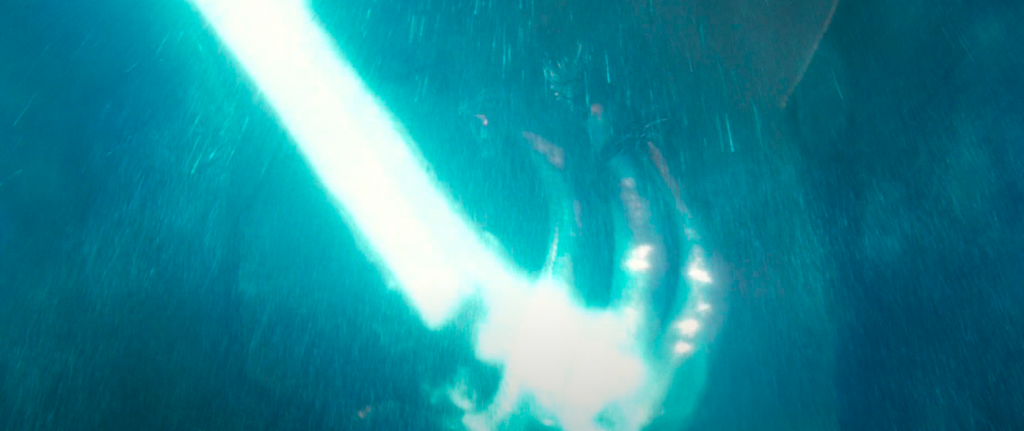
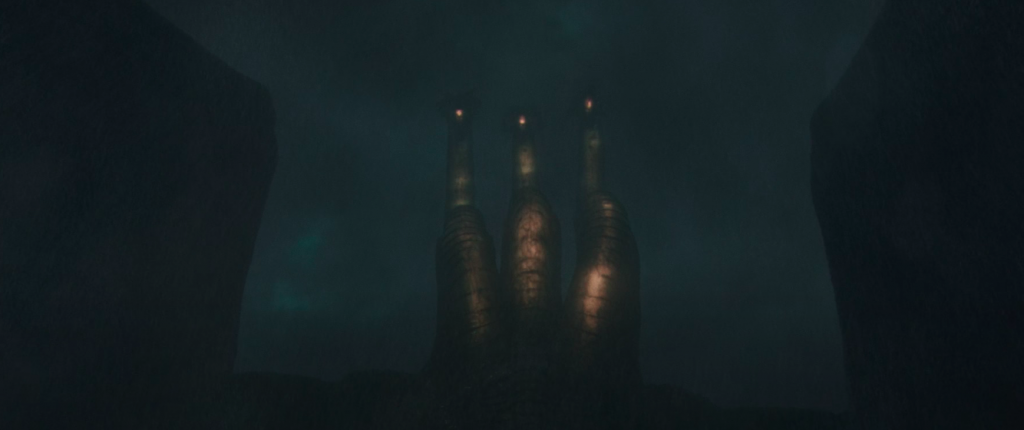
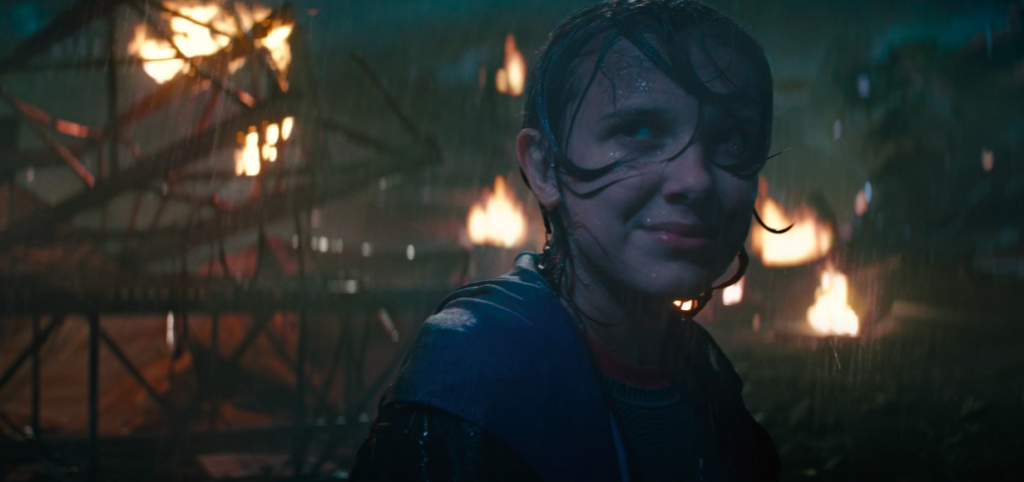
Alongside Godzilla’s arrival, a positive establishment of the human-animal bond has been expressed through a low-angle camera shot showing the mass amount of planes that are flying into battle with him (Figure 14). The camera angle is then brought down to his feet, showing more soldiers in ships entering the fight (Figure 15). The difference in these camera angles emphasise Godzilla’s size against the backdrop of the humans, but rather than inducing a state of fear, it is through the positive relationship between himself and the humans that we feel grateful and hopeful when in the presence of this overwhelmingly large creature.
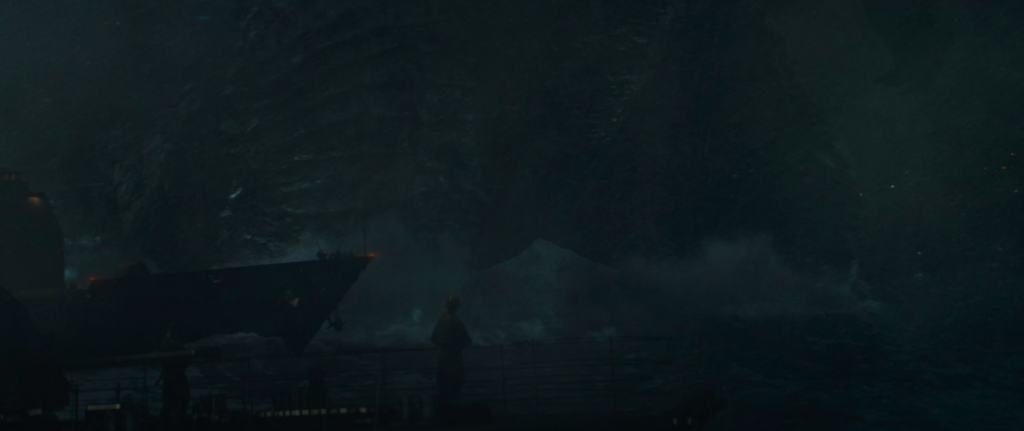
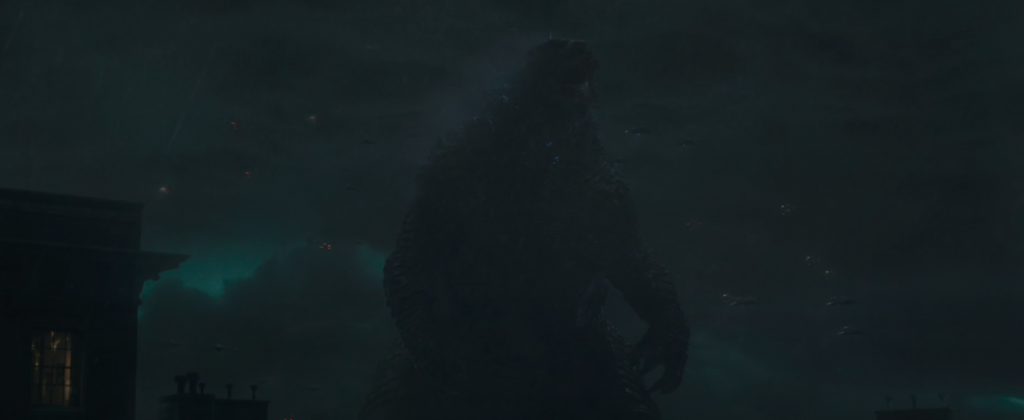
The moment of contact between Ghidorah and Godzilla is expressed through a wide shot which rapidly zooms in on the first touch of the two, immediately bringing the spectator to the level of battle and fully engrossing them into the conflict (Figure 16). The fast paced orchestra that is layered over this shot is combined with the roars and growls of the two creatures with an extreme wide shot showing the impact of the collision through a cloud that forms around them.
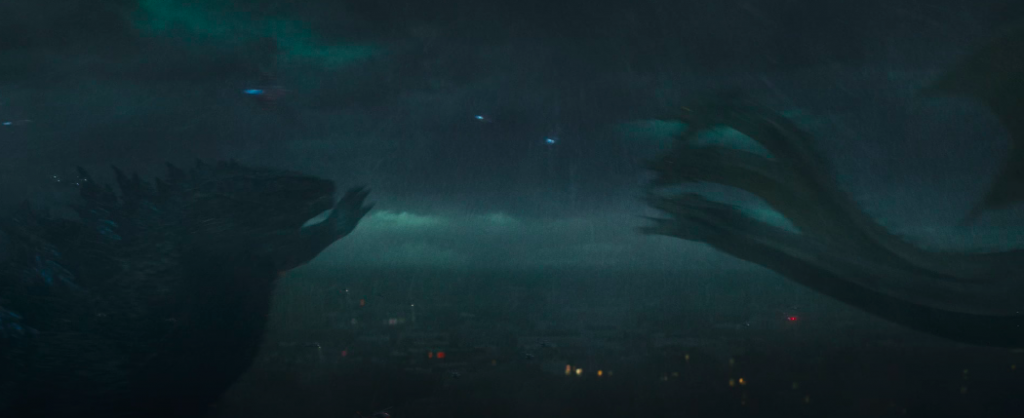
Godzilla’s final rise to power is introduced through the iconic low humming sound of his atomic breath, getting higher in pitch with each beat ready to reach its peak. For a sound that was once associated with fear and catastrophe, we feel comforted and relieved when we hear him approaching (Figure 17) .
Dougherty has emphasised the importance of respect and working hard to build a mutually beneficial relationship between humans and animals. Although this message has been portrayed fictionally through the use of Titans, the same rule applies to the animals that exist on our planet. It also suggests that the term ‘Monster’ should not just be associated with animals, as the film makes it clear that humans can also fall under this title. So, when questioning how we should define a ‘Monster’, it is important to not just take the appearance of something to make the assumption, as in terms of Godzilla, looks can be deceiving.
Ultimately, it is through the lighting, sound, and cinematography that Dougherty has presented the reluctant human-animal bond between Godzilla and the humans, whilst engaging in gender stereotypes and Godzilla’s Japanese heritage, it is clear that Godzilla has redeemed himself, transitioning from Kaiju beast to 21st Century hero through creating a positive and supportive network between himself and the humans of earth.
Bibliography
Barr, Jason, The Kaiju Film: A Critical Study of Cinema’s Biggest Monsters, (Jefferson: McFarland & co, 2016)
Molloy, Claire, ‘Animals, Avatars and the Gendering of Nature’, in Screening Nature: Cinema beyond the Human, ed. by Anat Pick and Guinevere Narraway (New York: Berghahn Books, 2013)
Tasker, Yvonne, Spectacular Bodies : Gender, Genre and the Action Cinema, 1st edn, (Oxfordshire: Taylor & Francis Group, 2006)
Tsutsui, W. and M. Ito, In Godzilla’s Footsteps : Japanese Pop Culture Icons on the Global Stage (US: Palgrave Macmillan, 2006)
Further Reading
Adam Roberts, The History of Science Fiction, 1st edn (London, Palgrave Macmillan, 2016)
Eric Lichtenfeld, Action Speaks Louder: Violence, Spectacle, and the American Action Movie, (Connecticut: Wesleyan University Press, 2007)
Jonathan Burt, Animals in Film (London: Reaktion, 2002)
Thomas Schatz, Hollywood Genres: Formulas, Film-making and the Hollywood System (Boston: Mcgraw-Hill, 1981)